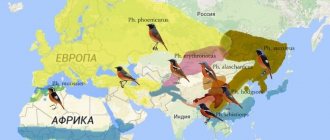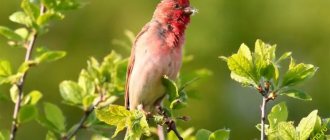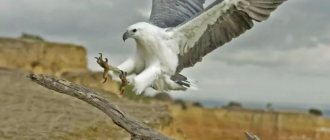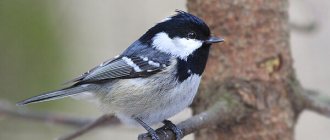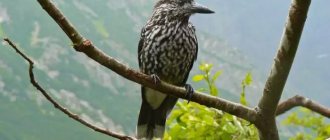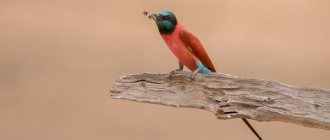The black vulture forms a separate species, which science attributes to the order Falconiformes, the family Accipitridae.
The habitat of vultures is mountainous and hilly areas. Birds prefer steppes, meadows and open forests that have not been developed by humans. Also, the favorite places of black vultures are the shores of lakes and rivers, since there is always food there.
Black vulture (Aegypius monachus).
Birds feel comfortable in pastures and alpine meadows located at an altitude of 4500 meters above sea level. These birds migrate mainly when they need to search for food. In the east, black vultures reach Korea, and in the west - to Portugal and Spain.
Species and man
The name "vulture" among ancient peoples refers to a legendary bird with a hooked beak, eagle wings and a lion's body. In some ancient religions, the vulture was considered a sacred bird. The peoples of Tibet, Tuva, and India left the bodies of their dead fellow tribesmen in the mountains, confident that the vultures would “take care” of them. The main deities of Babylon, Assyria, and Ancient Egypt were depicted with the head of a vulture. The chest decoration of the Egyptian pharaoh Tutankhamun also has an image of a vulture, and in the family coat of arms of the Romanov royal family, the mythological vulture occupies the main place.
Currently, the situation of vultures everywhere is very difficult. Despite their protected status, birds continue to be directly destroyed, nests are destroyed, and chicks are killed. Vultures also die on poisoned baits, although they are most often laid out for wolves and jackals. But the main limiting factor is the deterioration of feeding conditions associated with a reduction in the number of wild ungulates and a decrease in the number of livestock. When feeding on the corpses of domestic animals, vultures often die from the action of diclofenac, which is used in veterinary medicine and remains in the corpses for a long time.
To maintain the vulture population in some countries, for example in Spain, special feeding areas are created to support the existence of these birds.
Interesting facts about the bird
When fighting, the scavenger tries to fight off other birds with its wings, flapping sharply and rapidly, setting them vertically. This intensifies the blows; such maneuvers drive the competitor away from the food.
When fighting with a hyena or jackal, the bird strikes with both its wings and its powerful curved beak. Characteristics of black vultures: birds are calm, non-conflicting, balanced, patient and unperturbed.
They have a peaceful and good-natured nature. They have strong nerves, a lot of perseverance and patience. It has been noticed that when sharing food they do not have fights. Birds consume carrion and act as orderlies and forest cleaners.
Appearance
The black vulture is one of the largest birds in the world. Body length from 75 to 115 cm, wingspan up to 2.8 m, weight 10-12 kg. Unlike other birds of prey, males are slightly larger than females.
The plumage of adult birds is dark brown, almost black. The head is covered with down, and most of the neck has no feathers at all. Only its lower part is surrounded by a kind of frill collar made of white fluffy feathers. The skin on the head and neck is gray or pinkish-brown. The eyes are large and protruding, which indicates excellent vision. The beak is large, strong, adapted for tearing large prey (carrion). The paws, on the contrary, are weak and unsuitable for carrying prey.
Fish owl
This is a fish owl. We are accustomed to the fact that owls demonstrate wisdom and calmness by their appearance, but when you see this owl, you can definitely forget about calmness, because its dimensions range from 51 to 63 cm.
The span is 150 centimeters, and the body weight reaches 2.5 kilos. The main prey of this type of owl is also fish, and this is due to a number of features of the body structure of fish owls.
Since the prey is underwater and cannot hear the hunting owl, the owl’s wings lack their usual softness and it is difficult for her to fly silently. In short, everything is according to plan, and for the same reason, the fish owl has weakly acute hearing. There is something mysterious, unearthly about this nocturnal predator.
Nutrition and feeding behavior
Black vultures are typical scavengers. The nature of the plumage of the head and neck (or rather, the lack thereof), the structure of the beak, acute vision - everything is adapted not to active hunting, but to searching for and eating carrion. Vultures, using currents of warm air, rise to a height of 1 km and higher and fly around vast spaces, looking for the corpses of dead animals. In one day they can fly 300-400 km. In search of prey, birds not only carefully look at what is happening on the ground, but also watch their brothers or other scavengers. Keen vision allows the vulture to determine from a height whether an animal lying on the ground is breathing or not (and then it is its prey). Usually several eaters gather on the carrion, and fights and brawls occur between them. Larger vultures often push away smaller birds, and they have to wait until the vultures are full. Often vultures eat so much at one time that they cannot immediately take off. They move away from the remains of the meal and sit quietly in the sun, digesting their food and carrying out a kind of disinfection of their plumage under the influence of sunlight, which kills putrefactive bacteria. Observers describe cases when vultures, disturbed after feeding, were forced to regurgitate what they had eaten in order to take off.
wandering albatross
The next bird on our list is a representative of the albatross family. Their body length reaches approximately 170 centimeters. The main feature of the wandering albatross is that it has the largest range among all modern birds, namely up to 325 cm.
Really impressive. These birds have an incredibly powerful beak, which allows them to hunt with ease. The main diet is, of course, fish, shellfish and crustaceans. It is interesting that albatrosses tend to accompany ships that sail thousands of kilometers from the coast.
Reproduction and parental behavior
The black vulture nests in separate pairs or sparse colonies. The nest is made in trees, less often on rocks. The nest is very large, up to 2 m in diameter, made of large branches and twigs, with a bedding of thin branches, dry grass, wool, etc.
Mating occurs on the nest, and the vultures emit a characteristic quack and hiss.
The clutch contains 1 large egg, mottled, with reddish-brown spots on a white background. Both parents incubate in turn for 52-55 days. The chick is fed by regurgitating its food. Only after 3-3.5 months does the chick acquire a certain independence. Thus, the entire nesting period lasts 3-3.5 months. Nesting success is very low; no more than 25-48% of young survive to adulthood. Birds apparently become sexually mature no earlier than 5-6 years.
Ostrich
The ostrich is rightfully recognized as the largest bird in the world. But besides this, he is also the most resilient and fastest representative of birds. Its height reaches 2.7 m, its weight reaches 200 kg, and the speed that the animal can reach is 70 km/h. No wonder its name means “camel-sparrow”. Just one step taken by a bird is 4 meters. It is not entirely known how much an ostrich eats in the wild, but in captivity it requires 3.5 - 4 kg of food per day. Without teeth, it eats rocks for better digestion and can also swallow metal elements. The largest bird is very dangerous. With a blow from his powerful leg and a long claw, he is able to kill a large predator, even one as dangerous as a lion.
What does a vulture eat?
The peculiarities of the anatomical structure of vultures suggest that birds are able to digest only carrion, and that which is already in decomposed form. The acidity of the gastric juice of birds allows them to cope with various products that enter their stomach. This even applies to bones, which are easily digested internally.
The special composition of bacteria formed in the intestines of birds helps them neutralize even dangerous toxic substances that can be fatal for others.
Vultures, which fly at altitude for a long time, search for prey from above, as they have unique acute vision. As soon as prey is discovered, the birds dive down so as not to miss the option they like.
As a rule, vultures choose the carrion of ungulates, but sometimes they can eat other carrion.
Thus, the menu of vultures may consist of dead flesh:
- lam;
- antelope;
- crocodiles;
- young turtles;
- fish;
- bird eggs.
Recommended by topic
Flamingo Deer Starling
There are even insects in it, which birds “snack” between main meals.
Vultures often become a kind of accompaniment for predators that go hunting. Birds show great restraint and patience while waiting for predators to satisfy their hunger. Only after this do they approach the remains of the prey. Vultures are in no hurry: they can even wait for the death of a wounded victim, and then have a feast.
Vultures do not attack potential prey if they see that it is still showing signs of life. Birds will not make any effort to kill their prey, even if the animal is already severely wounded. In this case, the birds will wait until the remaining vital forces leave her.
Vultures flock together for a meal in a flock of about 10 birds.
During the meal, they butcher the prey quickly and methodically. In a few minutes, a flock of vultures can gnaw an entire antelope. To do this, birds use their hook-shaped beak. With its help, they tear open the belly of the victim and begin their meal by sticking their head inside.
Despite the diversity of the vulture population, it is not uncommon for birds from different species to gather in one place to sample the same prey. This is explained by the fact that representatives of different species choose different parts of the dead body as the basis for their diet. For some, the greatest value is the pulp and offal, for others - skin, tendons, etc.
Some types of vultures, due to their small size, cannot independently pierce the thick skin of the victim, for example, if we are talking about an elephant. Therefore, they wait until their larger and stronger relatives do it for them.
If everything is bad with vultures’ search for food, they are able to go without food for a long time.
Notes[ | ]
- Koblik E. A., Redkin Ya. A., Arkhipov V. Yu. List of birds of the Russian Federation. - M.: Partnership of Scientific Publications KMK, 2006. - P. 102. - ISBN 5-87317-263-3
- Boehme R. L., Flint V. E.
Five-language dictionary of animal names. Birds. Latin, Russian, English, German, French / Under general. ed. acad. V. E. Sokolova. - M.: Russian language, RUSSO, 1994. - P. 39. - 2030 copies. — ISBN 5-200-00643-0. - Gill F., Donsker D. & Rasmussen P. (Eds.): Hoatzin, New World vultures, secretarybird, raptors. IOC World Bird List (v11.1)
(20 January 2021). doi:10.14344/IOC.ML.11.1. Date accessed: February 20, 2022. - Current state of scavenger bird populations in Crimea (unspecified)
. cyberleninka.ru. Date of access: April 8, 2022.
Where does the vulture live?
Vultures are among the heat-loving birds that prefer to live in areas with hot or moderate climatic conditions. Birds are distributed almost everywhere: they can be seen on different continents, excluding Antarctica and Australia. The geography of distribution of vultures is extremely wide, it includes such areas as southern Europe, Central and South Asia, the Caucasus, Africa, and South America.
The largest number of representatives of this species live on the African continent. Each species of vulture settles on the territory of one continent: among these birds there are not the same species that live in different parts of the world.
Vultures prefer open areas to live in, where the territory can be viewed from above.
Recommended by topic
Blackbirds Woodpecker Heron
In this way, birds can detect prey in the air. Predators live in savannas, semi-deserts and deserts; they can choose mountain ranges where they settle on steep slopes.
Migratory species among vultures are practically not found (the exception is the turkey vulture, a species that belongs to the nomadic species). Birds live sedentary lives and occupy one, strictly limited territory. During the organization of hunting trips, the boundaries of the area where the birds live may be violated, as they get out of there in search of food.
Birds are quite large in size, and therefore they require nests of appropriate sizes - large and at the same time quite strong. Vultures prefer to build them in secluded places, choosing the wilderness for this: mountain slopes, grottoes in which birds hide and can hide from the wind, inaccessible rocks, forests that are impassable for people.
Birds also sometimes choose to live in swamps located in forests near water bodies.
Birds choose to live either alone or in married couples, which are characterized by monogamous behavior.
Elena
Ask a Question
Question to the expert
Why are vultures endangered?
Some species of vultures, such as the African species, are indeed endangered. This is due to the deterioration of the food supply, a decrease in the number of large domestic animals, hunting shootings, and birds getting caught in traps. The reduction of a significant number of vulture populations leads to the fact that they decided to take the birds for observation and protection. For example, they are often harmed by poisons and medicines used by people as part of agricultural activities. Therefore, the use of these drugs is sometimes prohibited in vulture habitat areas. Hunting activities are also limited.
Pink Pelican
flickr/Paul B Jones
Pink pelicans (lat. Pelecanus onocrotalus) are quite large waterfowl (175 cm in length). Being predators, they feed on fish, sometimes the chicks of other birds. He does not fish for long - usually from 8 to 9 am, catching 3-4 large fish, which is the norm for him. The wingspan of the pink pelican is 310 cm.
Natural enemies of vultures
Vultures are among the impressively sized birds of prey, which theoretically should determine their lack of enemies. However, in reality this is not the case. Despite the fact that the vultures are quite large, they are not very strong. As a result, birds are more cautious and try not to enter into conflicts with other predators. They are quite peaceful, but they also have to defend themselves, compete for food, etc.
The main competitors for carrion among vultures are hyenas, jackals and other birds of prey. When vultures need to fight off other flying predators, they use large wings to do this, with which they make sharp and rapid flaps, positioning the wings vertically. Due to such maneuvers, the bird of prey receives a powerful blow and flies away from the battlefield. If vultures have to fight with terrestrial predators, they use not only strong wings, but also a beak, which is very strong and is a powerful, penetrating tool.
Representatives of the same family practically do not conflict with each other and do not enter into open confrontation. The maximum they can do is to drive competitors away from the prey with their wings in order to try to catch the desired piece.
People whose activities significantly affect the size of the bird population can also be called a characteristic enemy of vultures. The number of vultures is constantly decreasing due to the plowing of the land, which leads to the destruction of the territories in which the birds establish their life. In addition, populations of ungulates, which vultures primarily feed on, are also declining, making it difficult to obtain food.
African marabou
flickr/leptofilo
African marabou (lat. Leptoptilos crumeniferus) is an inhabitant of African savannas and other open spaces of this continent. The marabou belongs to the stork family, and is therefore endowed with a huge beak, typical of all representatives of this family. It is the largest representative of the order of storks (115-152 cm in length). Wingspan - 287-320 cm. This scavenger soars over the savannah, spreading its huge wings, looking for food.
